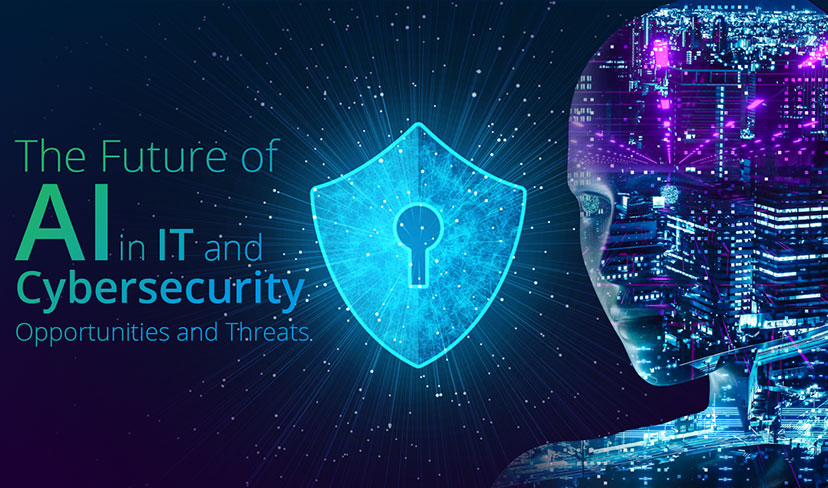The world of IT and cybersecurity is developing more quickly thanks to artificial intelligence’s (AI) quickening pace of change. We are seeing opportunities and threats emerge in this new digital world as AI systems continue to advance in sophistication and capability. The future of AI in IT and cybersecurity will be examined in this article, along with possible developments, new threats, and tactics for utilizing AI to strengthen our online defences.
The Growing Role of AI in IT and Cybersecurity
In recent years, AI’s capabilities have expanded exponentially, and its applications in IT and cybersecurity are becoming more and more clear. Several crucial areas where AI is anticipated to significantly progress include:
Automation and Efficiency
Network monitoring, threat detection, and incident reaction are just a few of the IT and cybersecurity duties that can be automated by AI-powered tools. By increasing efficiency and reducing reaction times, this automation can free up IT teams to work on more strategic projects.
Predictive Analytics
AI in IT can analyze vast amounts of data and identify patterns or anomalies, enabling organisations to predict and preempt potential cybersecurity threats. This ability to foresee possible attacks will empower organisations to take proactive measures to protect their digital assets.
Enhanced Decision-Making
IT and cybersecurity teams can make better decisions by using AI to analyse complex circumstances and provide insights to inform decisions. This may result in more effective resource distribution, enhanced risk management, and improved security tactics.
Emerging Threats Caused by AI
Despite its potential to revolutionise IT and cybersecurity, AI also introduces new challenges and threats. Some of the main concerns include:
AI-Powered Cyberattacks
Cybercriminals are increasingly using AI systems to initiate complex attacks as they become more sophisticated. These attacks might employ deep fake videos, autonomous malware that can adjust and avoid conventional security measures, and AI-generated phishing emails.
AI Bias and Discrimination
AI algorithms learn from the data they are fed, which can lead to biased or discriminatory outcomes if the data used for training is flawed. This could result in unfair treatment or exclusion of certain individuals or groups in IT and cybersecurity processes, perpetuating existing inequalities.
Loss of Privacy
The ability of AI to process and analyse enormous amounts of data presents a serious threat to people’s privacy. Privacy rights may be compromised as a result of the widespread use of AI in data mining, profiling, and surveillance, as well as the possible misuse of personal data.
Harnessing AI to Strengthen IT and Cybersecurity
Organisations must adopt a proactive and comprehensive approach to maximize the benefits of AI and address its potential threats. This involves:
Developing AI Ethics Frameworks
Organisations must create strong ethics frameworks that handle issues like transparency, accountability, and fairness in order to guarantee the responsible use of AI. These frameworks should serve as a guide for the creation, testing, and implementation of AI systems and guarantee that they reflect organisational ideals and social norms.
Investing in AI Security Research
Organisations must invest in AI security research, including the creation of fresh methods and tools to thwart cyberattacks powered by AI, if they want to remain ahead of emerging threats. To spur innovation in this field, cooperation between business, academics, and government organisations will be essential.
Implementing AI-Driven Security Solutions
To improve their IT and cybersecurity posture, organisations should investigate and implement AI-driven security solutions. Predictive analytics is used to identify potential vulnerabilities and risks, as well as employing AI-powered tools for threat detection, incident response, and network monitoring.
Fostering a Skilled Workforce
Organisations must invest in the training of a skilled workforce that can function in the quickly evolving IT and cybersecurity environment if they are to realise the full potential of AI. This involves fostering a culture of continuous learning and adaptation and offering employees the training and tools they need to develop the required cybersecurity and AI skills.
Promoting International Collaboration
Because AI is a global phenomenon, it requires international cooperation to handle new threats and opportunities. International collaboration between governments, business, and academics can make it easier to exchange best practices, create consensus standards, and establish universal standards for the use of AI in IT and cybersecurity.
The Road Ahead: Preparing for an AI-Driven Future
As AI in IT continues to advance and reshape the cybersecurity landscape, organisations must prepare for both the opportunities and challenges it presents. To navigate this new era, several key steps should be taken:
Embracing a Holistic Approach
Businesses must take a comprehensive strategy to AI in IT and cybersecurity, taking into account not only the technical aspects but also the ethical, legal, and social ramifications. This necessitates the creation of thorough plans that incorporate AI into every aspect of IT and defence operations.
Encouraging Public-Private Partnerships
To promote progress in AI and cybersecurity, governments and private sector organisations should collaborate. Partnerships between the public and private sectors can close gaps in study, development, and implementation, advancing the creation of new technologies and ensuring their safe and responsible application.
Strengthening Regulatory Frameworks
Existing regulatory frameworks may need to be updated or expanded as AI becomes more common to handle the new problems it creates. In order to create and adopt regulations that encourage the responsible use of AI while preserving individual rights and freedoms, governments should have ongoing discussions with stakeholders.
Raising Public Awareness
Greater public awareness of the benefits and risks of AI in IT and cybersecurity is crucial to promote responsible adoption and ensure a balanced understanding of this transformative technology. Educational initiatives and public discourse can help demystify AI and foster informed decision-making among individuals, businesses, and policymakers alike.
Conclusion
Future IT and cybersecurity applications of AI hold both significant possibilities and unheard-of difficulties. Organisations can take full advantage of AI to bolster their digital defences and spur innovation by creating strong ethical frameworks, investing in AI security research, adopting AI-driven security solutions, and encouraging global collaboration. Nevertheless, it is crucial to stay alert and proactive in tackling the new risks that AI poses, ensuring that this potent technology is applied sensibly and for the benefit of all. We can sculpt a future in which AI contributes to the IT and cybersecurity environment for the better by adopting a forward-looking mindset and having ongoing conversations.
Rickie Sehgal, Chairman of Transputec Ltd







